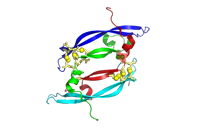Invited Speakers
A list of confirmed speakers is as follows:
Jasna Brujic, New York University, USA
Views of protein folding from a statistical physics approach to single molecule experiments
Jane Clarke, University of Cambridge, Department of Chemistry, UK
Lessons that can be learned from studying the folding of protein families
Giovanni Dietler, EPFL, SWITZERLAND
DNA manipulation
Ruxandra Dima, University of Cincinnatti, USA
Multiscale simulations of the mechanics of filamentous proteins
Marc Fabian, McGill University, Montreal, CANADA
Structural insight into gene silencing programs that employ the CCR4-NOT deadenylase complex.
Patricia Faisca, University of Lisboa, PORTUGAL
Intermediate states for protein folding and aggregation
Neil Ferguson, University College, Dublin, IRELAND
Molecular mimicry in hepatitis B virus: How a viral intrinsically disordered protein helps hijacks the host membrane-trafficking machinery
Piotr Garstecki, Institute of Physical Chemistry PAS, Warsaw, POLAND
Automated droplet microfluidics for studies of emergence of drug resistance in bacteria
Peter Hinterdorfer, Institute for Biophysics, Christian Doppler Laboratory of Nanoscopic Methods in Biophysics, Johannes Kepler University Linz, AUSTRIA
Molecular recognition force microscopy/spectroscopy
Robert Holyst, Institute of Physical Chemistry, Warsaw, POLAND
Biologistics: mobility of ligands, proteins and plasmids in cytoplasm of the eukaryotic and prokaryotic cells
Gerhard Hummer, NIH Bethesda, MD, USA
Structure, dynamics and function of supramolecular assemblies from simulation and experiment
Thomas Kiefhaber, Technical University Munich, Biophysical Chemistry, GERMANY
The unlocked state: a clue to understand how proteins fold and unfold
Andrzej Kloczkowski, The Ohio State University, Columbus, OH, USA
New Methods to Improve Protein Structure Prediction and Refinement
Andrzej Kolinski, University of Warsaw, Chemistry Department, Poland
CABS - coarse grained modeling of protein structure assembly, dynamics and interactions
Robert Leheny, Physics Department, Johns Hopkins University, Baltimore, MD, USA
Viscoelastic behavior of proteinic surfaces
Adam Liwo, University of Gdansk, POLAND
Mean field dipole-dipole interactions as essential factors in the formation of biomolecular architecture
Amos Maritan, University of Padua, ITALY
Cristian Micheletti, SISSA, Trieste, ITALY
DNA knotting inside viral capsids: a computational approach
Wladek Minor, University of Virginia, Charlottesville, USA
Experiment and modeling: competitive or complementary approaches to structural biology?
Pawel Pomorski, Nencki Institute PAS, Warsaw, POLAND
How cell adhesion can influence nucleotide-dependent calcium signal: the idea of signalosome and it's practical implementation
Wouter Roos, Vrije Universiteit, THE NETHERLANDS
Dual structural role of the viral RNA: capsid stabilization vs. genome uncoating
Joerg Rottler, University of British Columbia, Vancouver, CANADA
DNA bundles
Catherine Royer, Centre de Biochimie Structurale, Montpellier, FRANCE
Pressure effects on protein stability - The devil is in the details
Joan-Emma Shea, UC Santa Barbara, USA
Simulation of protein aggregation
Andrzej Sienkiewicz, EPFL, Lausanne, SWITZERLAND
Multifunctional magnetic-photoluminescent-photocatalytic nanostructures for biomedical applications
George Stan, University of Cincinnatti, USA
Models of chaperons
Jaroslaw Stolarski, Institute of Paleobiology PAS, Warsaw, POLAND
How meanignful is prefix "bio" for minerals formed by organisms: the nanoscale perspective
Marek Tchorzewski, UMCS, Lublin, POLAND
The ribosome action as transitions between different functional/structural states driven by energy obtained from GTP hydrolysis
Damien Thompson, Tyndall Institute, Cork, IRELAND
Nanoscale computer-aided design of self-assembling materials for electronics and health applications
Andrew Travers, LMB, Cambridge, UK
Chromosomes as topological machines
Joanna Trylska, CeNT University of Warsaw, POLAND
Ribosomal RNA as a target for sequence-specific inhibition
Rebecca C. Wade, Heidelberg Institute for Theoretical Studies and Heidelberg University, GERMANY
Protein Dynamics and Molecular Recognition: Insights from Simulations
Gijs Wuite, Vrije Universiteit, THE NETHERLANDS
The Nanomechanics of Viruses
Piotr Zielenkiewicz, IBB, Warsaw, POLAND
Whole cell model of translation
Boguslaw Baginski, University of Warsaw, POLAND
Zircon - small but great


